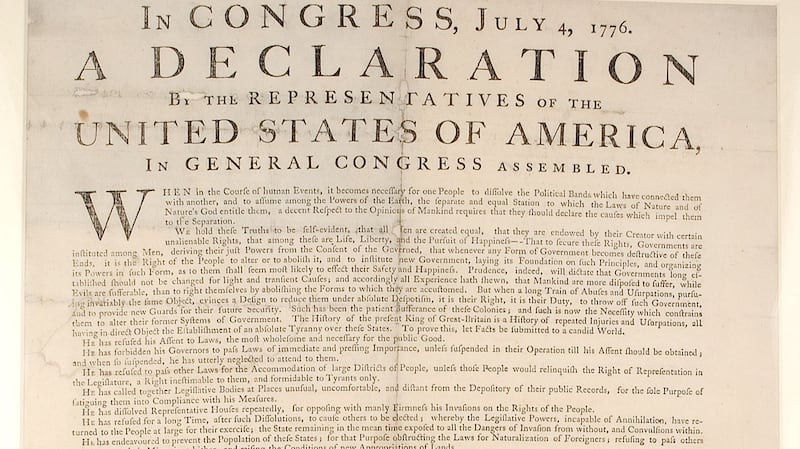“We hold these truths to be self-evident, that all men are created equal, that they are endowed by their Creator with certain unalienable Rights, that among these are Life, Liberty and the pursuit of Happiness . . . ”
The opening of the American Declaration of Independence is one of the most resonant sentences in the English language, packing a literary punch to rival the greatest hits of Shakespeare and the King James Bible. It was penned, of course, by Thomas Jefferson. But if it hadn't been for the heroic efforts of a young Irish printer, the document might not have been distributed and accepted so quickly across the fledgling United States.
John Dunlap was born on Meeting House Street in Strabane, Co Tyrone, in 1747. At the age of 10 he set off for Pennsylvania to work with his uncle William, a bookseller and printer in Philadelphia. He was an assiduous apprentice; within a decade the older Dunlap, who had decided to become an Anglican clergyman, was able to go off and study theology, putting the shop into the capable hands of his teenage nephew.
Instalments
Dunlap bought the business by paying off his debt to his uncle in instalments. According to Dr Benjamin Rush, a close family friend, he was so poor at this time in his life that he lived in the shop, sleeping on the floor under the counter.
In 1771 Dunlap started a weekly newspaper, the Pennsylvania Packet, which quickly became a successful daily. During his time as publisher of the Packet he wrote a letter home, urging more of his fellow Irishmen to come to America: "The young men of Ireland who wish to be free and happy should leave it and come here as quickly as possible. There is no place in the world where a man meets so rich a reward for conduct and industry."

Freedom was certainly in the air. In 1773, representatives of 13 American colonies set up what they called the “Continental Congress” with a view to securing independence from British rule. When the war began Dunlap became an officer in Pennsylvania’s city cavalry, where one of his duties was to act as bodyguard to George Washington at the battles of Trent and Princeton.
Astutely, however, Dunlap also carried on with his printing work. In 1776 he secured a lucrative contract with the new American government that, on July 2nd, voted to secede from Great Britain.
Two days later the Congressmen approved the final wording of their “declaration of independence” – and on the night of July 4th, 1776, a hand-written copy of the first draft was whisked from Congress to Dunlap’s shop a few blocks away. The printer, then 29 years old, spent much of the night setting type, correcting it, and running off several hundred broadside sheets.
Speculated
Imagine being a fly on the wall in the printworks that night. It has been speculated that Benjamin Franklin, the greatest printer of his day, may well have been there to supervise the operation. The anxious author, Thomas Jefferson, may also have dropped in. According to the historian Ted Widmer, there is evidence of haste in the finished documents: “watermarks are reversed, some copies look as if they were folded before the ink could dry and bits of punctuation move around from one copy to another”. Nevertheless, by dawn the first printed copies of the historic papers, now known as the Dunlap broadsides, were ready to be sent across the colonies.
Meanwhile the ever-shrewd Dunlap was taking advantage of the chaos that reigned during the war of independence. By snapping up pieces of land confiscated from colonists who refused to take Pennsylvania’s new loyalty oath, he made a small fortune out of property development and retired at 48, a wealthy man. But if Dunlap’s is a classic “American dream” narrative, it has something of an “American nightmare” ending. Retirement obviously didn’t agree with him and he took to drink in a big way. “In his family,” reports Dr Benjamin Rush, “he was less amiable and respectable than in society. Towards the close of his life he became intemperate so as to fall in the street.”
Dunlap died on November 27th, 1812. His birthplace in Strabane is marked by a plaque, while a nearby 18th-century shop, Gray’s Printing Press – said to be where he learned his trade as a young boy – is maintained as a museum, with tours available on request.











